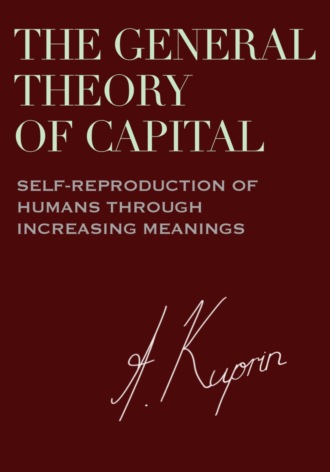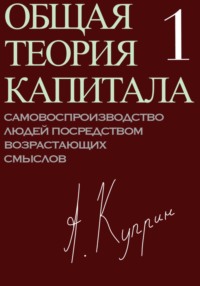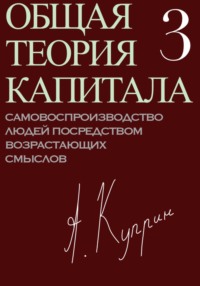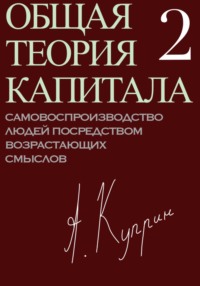
Полная версия
The General Theory of Capital: Self-Reproduction of Humans Through Increasing Meanings
“… The cultural equivalent of the genotype is the information stored in people’s brains that represents their beliefs, attitudes, values, skills, knowledge, and so on. The cultural equivalent of the phenotype is the expression of that information in the form of behavior, speech, and artifacts. It is the latter—the phenotype equivalent—that is copied during cultural transmission: we do not directly acquire neural patterns of activation in people’s brains; we copy people’s behavior, we listen to what they say, and we read what they write” (Mesoudi 2011, p. 44).
In nature, inheritance occurs in a direct order: first, genetic content is copied, and then the genotype, in interaction with the environment, shapes the phenotype, the external characteristics of organisms. Cultural inheritance is indirect: imitation, that is, copying the expression in the plane of norms, precedes the understanding of the content. An idea is passed through the medium. Understanding this difference between the direct transmission of genes and the indirect transmission of meanings was one of the initial problems of memetics, which, starting from the scientific apparatus of genetics arrived at the concept of the meme. “[A] significant worry for memetics is that when the same ideas do spread through a population, it is rarely because they are literally copied from each other” (Lewens 2018).
The evolutionary variation of meanings depends on their correct repetition by successive human generations. The inability of people to authentically repeat a meaning leads to its demise. Therefore, as Henrich shows, people tend to “over-imitate,” mimicking meanings with excessive accuracy (Henrich 2016, pp. 108-109). The ability to improve meanings (or at least not allow them to degrade) depends, all other things being equal, on the size and sociality of the human population. Thus, the size and quality of a society influence the path of its cultural evolution and the adaptive landscape of its meanings.
The difference between indirect cultural transmission and direct transmission of genes means that meanings can negatively affect human survival. If the survival of genes depends entirely on the survival of organisms that possess those genes, then meanings are not strictly tied to their carriers, allowing harmful meanings to spread throughout the human population. “…Oblique transmission opens up the possibility that some traits may spread through a population in spite of the fact that they reduce the fitness of the individuals who bear them” (Lewens 2018). Well-known examples include alcoholism and drug addiction.
The evolution of social learning went through two phases: (1) early social learning, which transmitted simple meanings that each individual could rediscover through individual learning (that is, independent discovery or invention), and (2) cultural learning, which transmitted meanings, that an individual, regardless of his abilities, could not rediscover independently in his entire life.
Social learning is characteristic of the early stages of cultural selection, when meanings were conveyed between hominids on the basis of their herding behavior, that is, their animal sociality. The early meanings themselves were still part of the animal behavior and appeared as animal signals and tools. If meanings got lost in the course of transmission, they could be rediscovered or reinvented through self-learning. In the later stages of cultural selection, meanings had left the realm of nature and formed an independent realm in which active abstractions in their shape of a word and a tool gradually decoupled from immediate animal behavior. Now meanings were transmitted through cultural learning; the complexity of meanings no longer allowed them to be simply reinvented if the community had lost them for some reason. At the same time, cultural learning enabled the transition from the collection of individual experiences to the growing accumulation of meanings from generation to generation.
Meaning as a common language of all humans
Eva Jablonka and Marion Lamb noted that “the transition to human societies with linguistic communication required changes in anatomy and sensorimotor systems and an increase in cognitive ability, but the part of the transition that is most difficult to explain is how humans acquired the capacity to quickly master the complex rules of grammar when young” (Jablonka and Lamb 2006, p. 243). They suggested that this ability may have arisen in the course of the co-evolution of genes and culture. Originally, linguistic information was transmitted through social learning. However, as linguistic communication became more crucial for proto-human groups, cultural selection of individuals took place based on their ability to learn the basics of language, leading to partial genetic assimilation of those basics. Given this assumption, the question arises: how can it be that every child today can learn any of the five or six thousand human languages. The answer could be either that by the time the genetic capacity for language evolved, all proto-humans had the same language and that no change in the genetic capacity was required for further language evolution, or that the genetic capacity evolved relative to a base common to all languages.
The first option, according to which the same language existed for hundreds of thousands and millions of years in different pre-human groups, seems unlikely. The evolution of languages over the last few thousand years is well studied from written sources and shows that languages diverge rapidly as their speakers spread geographically. The second, more likely, option assumes that the genetic ability to learn languages evolved in relation to their common base. Individual languages form the plane of expression of this base. Damian Blasi and his colleagues, after analyzing the “basic vocabulary” of 40 to 100 lexical items from 62 percent of the world’s 6,000 languages, showed that there is a stable connection between sound and meaning: lexical items with similar meanings have similarities in sound. This similarity may be due to the origin of different languages from a common ancestor, to borrowings between languages, or to other reasons that make certain sounds preferable for expressing certain meanings (Blasi et al. 2016).
At one time, Isaac Newton and Gottfried Leibniz independently developed not only differential calculus but also the idea of a single human language based on the nature of things themselves. Newton wrote: “The dialects of each language being so divers and arbitrary a general Language cannot be so fitly deduced from them as surely as from the natures of the things themselves, which is the same for all Nations and by which all Language was at the first composed” (Elliott 1957, p. 7). Leibniz believed that there is an alphabet of human thought, made up of simple concepts or “letters” and that innate language is based on this alphabet (Wierzbicka 2011, p. 379).
Strange as it may seem, thoughts are not made of concepts, not of images, not of letters, not of words. Thoughts are made of meanings. Douglas Hofstadter says in I Am a Strange Loop (2007):
“No one has trouble with the idea that ‘the same novel’ can exist in two different languages, in two different cultures. But what is a novel? A novel is not a specific sequence of words, because if it were, it could only be written in one language, in one culture. No, a novel is a pattern—a particular collection of characters, events, moods, tones, jokes, allusions, and much more. And so a novel is an abstraction, and thus ‘the very same novel’ can exist in different languages, different cultures, even cultures thriving hundreds of years apart” (Hofstadter 2007, p. 224).
Meaning, or social and material abstract action, is the common content of all languages, it is the base in relation to which languages function as elements of the plane of expression. Meaning is connected with its linguistic expression through an active linguistic norm and is transmitted thanks to this norm. Evald Ilyenkov wrote in his Considerations on the Relationship between Thinking and Language (1977):
“The ‘deep structures’ identified by Chomsky actually take shape in ontogenesis, in the process of a child’s development before he can speak and understand speech. And one does not have to be a Marxist to recognize their obvious, one might say, tangible reality in the form of sensorimotor schemes, i.e. schemes of the direct activity of a developing human being with things and in things in the form of a purely bodily phenomenon—the interaction of a body with other bodies located outside it. These sensorimotor schemes, as Piaget calls them, or ‘deep structures,’ as linguists prefer to call them, are precisely what philosophy has long called logical forms or forms of ‘thinking as such’” (Ilyenkov 2019-, vol. 5, pp. 243-244).
Can a human being understand things without using words? Can language be reduced to gestures and tactile sensations rather than words? Although the Zagorsk experiment on teaching deaf-blind children did not provide a definitive answer to this question, we are inclined to believe that this is probably impossible. Meanings and words are inextricably linked for humans.
Studying the language development of a child is a key to understanding the language development of all humanity. A child learns language through a socially activated plane of expression, saturated with active norms. Active norms in this case are sensorimotor schemes and the event models and action programs built on them: connections between symbols (words, gestures) and actions: “eat,” “drink,” “sleep,” “walk,” etc. A child is predisposed to internalize these connections.
3. Traditional choice and cumulative culture
Meanings, counterfacts and choices
Konstantin Tsiolkovsky once said that the concentration of energy in stars preceded the evolution of organisms (Tsiolkovsky 2004, p. 105). Life with its laws of selection has its origin in the inanimate nature with its laws of collection (or gravity). Culture, in turn, has its origin in life. Organic evolution occurs through selection within populations: genetic variability requires a change of generations of individuals. Cultural evolution begins as an extension of natural selection, as a mixed selection of individuals, which occurs not only on the basis of variations in genes, but also on the basis of variations in meanings. However, if genes, as elements of biological information, are rigidly tied to populations of individuals and cannot change independently of the organisms as their carriers, then meanings, as elements of cultural information, as socially transmitted material abstract actions, can change independently of human organisms within the framework established by the active power of man, his instincts, practices and reason.
As Leonid Krushinsky has shown, in the lower stage of biological evolution, the behavior of animals is mainly influenced by instincts, while as the nervous system becomes more complex, learning (practice) plays an increasingly important role in adaptive behavior. In modern humans, with their differentiated cerebrum, behavior is largely determined by reason (Krushinsky 1986, pp. 135-136). At the same time, “the basis of intelligent action is an extremely broad norm of reaction; behaviors performed with the participation of reason can go far beyond the forms of behavior that arose as adaptations to specific living conditions” (Krushinsky 1986, p. 80). Since intelligence, as a late product of mixed selection, has not been refined by it as much as learning, the frequent solving of new problems can lead to neuroses (ibid., pp. 228-229).
Practice and intelligence are not exclusively human characteristics. Animals also have their own animal “traditions” and their own “intelligence.” However, the difference between an animal and a human is not purely quantitative, as Darwin saw it. The difference is qualitative: animals use means but remain in nature. Their means and methods do not form a domus that would separate itself from the natural habitat.
Robert Sapolsky points out that the broad reaction norm underlying human intelligence is itself a result of evolution (we would say mixed selection) that has freed the human brain from the tight control of the genetic program:
“The brain is heavily influenced by genes. But from birth through young adulthood, the part of the human brain that most defines us is less a product of the genes with which you started life than of what life has thrown at you. Because it is the last to mature, by definition the frontal cortex is the brain region least constrained by genes and most sculpted by experience. This must be so, to be the supremely complex social species that we are. Ironically, it seems that the genetic program of human brain development has evolved to, as much as possible, free the frontal cortex from genes” (Sapolsky 2017, p. 173).
The development of reason, with its broad norm of reaction, is synonymous to the development of counterfacts (counterfactuals). Counterfacts are, one might say, alternative facts—actions and things that could have been but were not done, that were not added to the stable cultural repertoire and were not passed on through learning. Counterfacts arose along with meanings as their random versions brought about by variations in plans and actions. In itself, this randomness was only the intersection of existing patterns: “what we see as fundamental randomness may be the result of simple interacting rules” (Page 2009, p. 38). As meanings evolved, counterfacts began to acquire their own meaning, transforming into an alternative world of “as ifs.” In his Book of Why (2018), Judah Pearl cites as an example of a counterfact a figurine carved from the tusk of a mammoth 40,000 years ago—the “Lion Man” as a fantastic cross between man and animal (Pearl and Mackenzie 2018, pp. 34-35).
Pearl identifies three rungs on the ladder leading to knowledge of causes: “seeing,” “doing,” and “imagining.” On the first rung are animals and computers, which learn through association (Ivan Pavlov spoke of conditioned reflexes here). On the second rung are early humans who intervene in events, use tools, and act according to a plan rather than simply imitating, and children who experiment and learn from experience. Finally, on the top rung are “counterfactual learners” who “can imagine worlds that do not exist and infer reasons for observed phenomena” (Pearl and Mackenzie 2018, p. 28).
The evolution of meanings began as mixed selection but continued as choice (cultural election, to use a Latin term). Unlike cultural selection, cultural choice is an evolutionary variation of meanings, achieved by the alternation of generations not of humans, but of meanings. At this stage, the development of meanings gets independence from the development of the human body. Meanings cease to be an extension of the human organism and become a substance external to it. From the object of biocultural co-evolution, man transforms to its subject, taking on the function of denying facts, generating counterfacts and accelerating their selection. The evolving ability to deny the facts raised human understanding to reason. Nikita Moiseev called this the transition “from the strategy of nature to the strategy of reason” (Moiseev 1990, p. 223). If mixed selection was a joint action of the forces of nature and culture, then choice is a purposeful human action. Choice is both an action and a result of an action, that is, the choice between counterfacts is itself a (counter)meaning.
In his lecture course Understanding Complexity (2009), Scott Page makes a fourfold distinction between systems in which diversity is the result of selection and systems in which diversity is the result of choice (Page 2009, p. 14):
● The size of the jumps: selection proceeds in small jumps; choice can occur in large jumps: in the evolution of living things, an elephant and a tiger cannot be crossbred, but in the evolution of meanings they can;
● Viability of intermediate states: in selection, all intermediate stages must be independently viable; in choice, intermediate stages may not be able to function independently: the main thing is that the final state is viable;
● Method of representation: selection is “tied” to a single coding method—for example, genetic—and choice can be made in various symbolic systems;
● Continuity: selection is continuous and is carried out by a random search through all possible options; choice is discrete and bound to a finite set of options.
As Jean-Luc Nancy said, the subject is “what (or the one who) dissolves all substance—every instance already given,” “the subject is what it does, it is its act, and its doing is the experience of the consciousness of the negativity of substance” (Nancy 2002, p. 5). Man, considered from the perspective of his agency or active power, is the (counter)meaning that denies culture as given, creates something new and is itself this new. Election is an accelerated selection. With its transition to the choice of meanings, the evolution of culture accelerated in relation to the evolution of the human body. The evolution of culture-society proceeded from this point on faster than the evolution of the human body and psyche. To which section of the Henrich-Popov bridge can the emergence of counterfacts and choice be attributed? To the emergence of modern man about 200,000 years ago? Or much earlier? Or much later? We just do not know.
Traditional society and the accumulation of experience
Both natural and cultural selection (the latter arising from the former) occur in two steps: the first step is mutation, that is, a random change in genes/meanings, and the second step is inheritance, that is, the transmission of genes/meanings that ensure successful adaptation to the environment. The difference between selection and choice is that choice essentially occurs in one step, combining ideas about possible actions (counterfacts) and the action itself (meaning). In this one step, the chosen action is carried out. With the advent of choice, the evolution of meanings followed Lamarck, not Darwin: people began to select meanings purposefully, while retaining the meaning features they needed. Now the figurative “giraffe” actually began to grow a neck as it reached up for leaves, because people kept the offspring of just such a “giraffe.”
“Biological evolution is a bad analogue for cultural change because the two systems are so different for three major reasons that could hardly be more fundamental. First, cultural evolution can be faster by orders of magnitude than biological change at its maximal Darwinian rate—and questions of timing are of the essence in evolutionary arguments. Second, cultural evolution is direct and Lamarckian in form: The achievements of one generation are passed by education and publication directly to descendants, thus producing the great potential speed of cultural change. Biological evolution is indirect and Darwinian, as favorable traits do not descend to the next generation unless, by good fortune, they arise as products of genetic change. Third, the basic topologies of biological and cultural change are completely different. Biological evolution is a system of constant divergence without subsequent joining of branches. Lineages, once distinct, are separate forever. In human history, transmission across lineages is, perhaps, the major source of cultural change. Europeans learned about corn and potatoes from Native Americans and gave them smallpox in return” (Gould 1992, p. 65).
Biological evolution is based on the variability and inheritance of genes and the natural selection of organisms with a genotype that promotes adaptation to the environment. Man as a living being is the basis of society and culture. Therefore, in primitive communities, the mechanism of natural selection continues to operate, influencing the instinctive behavior of people. People are still guided by instincts and emotions, which are to some extent restricted by cultural norms: traditions and prejudices relayed through learning overlay instincts and override them. Cultural evolution is based on the inheritance of meanings, their variation and the selection of people with meaning types that contribute to adaptation to the environment:
“Here’s the idea, broken down into its simplest form. We’ve established that from a very young age, humans focus on and learn from more skilled, competent, successful, and prestigious members of their communities and broader social networks. This means that the new and improved techniques, skills, or methods that emerge will often begin spreading through the population, as the less successful or younger members copy them. Improvements may arise through intentional invention as well as from lucky errors and the novel recombinations of elements copied from different people” (Henrich 2016, pp. 212-213).
While cultural selection was the selection of facts based on implicit norms, traditional choice is the choice of counterfacts based on explicit norms. Traditional choice was still heavily dependent on norms and relied on practices transmitted through cultural learning. But even this traditional choice, based on the random drift of meanings and a deliberate retention of chance, eventually allowed humans to move to artificial selection, that is, the choice of animals and plants. About 30,000 years ago, the supposed domestication of the dog began the transition from hunting and gathering to herding and farming.
The rise of traditional choice as a driving force of social change did not lead to any “primitive revolutions.” We prefer to call the domestication of animals and plants agricultural evolution because this process took thousands and tens of thousands of years. Early human inventions and discoveries were happy accidents that were able to persist through the selection of the populations that made those discoveries and inventions. In a traditional society, intelligence and purposeful choices of individuals contributed to cultural evolution but did not yet play a prominent role. Human practices and prejudices dominated traditional society and ensured its survival.
It is hard for modern humans to accept the idea that developed intelligence is not a competitive advantage. However, this was well understood by members of traditional societies who relied not on intelligence but on practices in order to adapt to their environment. Joseph Henrich illustrates this with the example of Franklin’s expedition frozen in the Arctic ice in the 1840s:
“…Inuit snow houses look designed and are clearly functionally well fit to life in the Arctic. In fact, they appear to call for a team of engineers with knowledge of aerodynamics, thermodynamics, material science, and structural mechanics. Not surprisingly, facing the real threat of freezing to death in their tents, Franklin’s men didn’t figure out how to make snow houses. No single individual or even a group of a hundred highly motivated men in this case, could figure this out. It’s a product of cumulative cultural evolution and contains features that many or most Inuit builders just learn as ‘that’s the way you do it’ without any big causal model” (Henrich 2016, p. 115).
Traditional society accumulates cultural experience through practices passed down from generation to generation. Socio-cultural order and causal models are prerequisites for counterfacts and choice: in a situation of total uncertainty, choice is impossible. In this society, individual intelligence and counterfactual choice play a significant but subordinate role. They cannot accelerate the accumulation of cultural experience to the speeds to which modern people are accustomed.
Meanings, genes and memes
The idea that culture is made up of elements is nothing new. We will not review the entire long history of such research here, but will focus on memetics. In his 1976 book The Selfish Gene, Richard Dawkins hypothesized a unit of cultural transmission that he called a meme: “We need a name for the new replicator, a noun which conveys the idea of a unit of cultural transmission, or a unit of imitation” (Dawkins 1976, p. 206). Dawkins introduced the concept of a meme by analogy with a gene.






